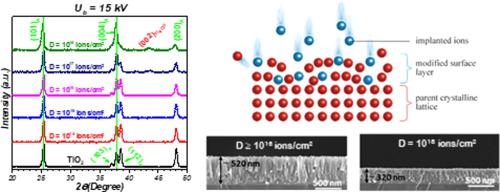当前位置:
X-MOL 学术
›
Appl. Surf. Sci.
›
论文详情
Our official English website, www.x-mol.net, welcomes your feedback! (Note: you will need to create a separate account there.)
Experimental and theoretical study of the synthesis of N-doped TiO2 by N ion implantation of TiO2 thin films
Applied Surface Science ( IF 6.7 ) Pub Date : 2021-03-01 , DOI: 10.1016/j.apsusc.2020.148493 A. Panepinto , D. Cossement , R. Snyders
Applied Surface Science ( IF 6.7 ) Pub Date : 2021-03-01 , DOI: 10.1016/j.apsusc.2020.148493 A. Panepinto , D. Cossement , R. Snyders

|
Abstract Since major limitations of the Dye-Sensitized Solar Cells (DSSCs) efficiency are assumed to come from (i) the low resistivity of the generally used TiO2 (ρ = 1 Ω.cm) and (ii) the undesired electron-hole recombination at the semiconductor/dye-electrolyte interfaces, the development of N-doped TiO2 semiconductor (TiO2:N) has attracted considerable interest. However, the synthesis of this material still remains a challenge as it is difficult to monitor (i) the doping level and (ii) the position of the nitrogen atoms into the titanium oxide lattice. In this context, the combination of Reactive Magnetron Sputtering (RMS) and Ion implantation (II) recently allowed to finely control the nitrogen chemistry of N-doped TiO2 materials. However, the structural properties, such as the crystalline constitution and morphology of the implanted materials are of crucial interest for the intended application. Therefore, we performed a parametric study of the ion beam parameters on the physical and chemical properties of TiO2:N in the aim of charge transport application in DSSCs and the results were supplemented by a simulation tool (i.e. TRIDYN software), allowing to distinguish this work from the others. Briefly, we observed that the sputtering of the ion implanted layer prevails with low accelerating voltages while the ion implantation process and its intrinsic effects are observed for high accelerating voltage conditions. We also demonstrated that the sputtering effect issue can be quite easily avoided for low dose conditions.
中文翻译:

N离子注入TiO2薄膜合成N掺杂TiO2的实验与理论研究
摘要 由于染料敏化太阳能电池 (DSSC) 效率的主要限制被认为来自 (i) 通常使用的 TiO2 (ρ = 1 Ω.cm) 的低电阻率和 (ii) 在在半导体/染料-电解质界面,N 掺杂 TiO2 半导体 (TiO2:N) 的发展引起了相当大的兴趣。然而,这种材料的合成仍然是一个挑战,因为很难监测 (i) 掺杂水平和 (ii) 氮原子在氧化钛晶格中的位置。在这种情况下,最近反应性磁控溅射 (RMS) 和离子注入 (II) 的组合允许精细控制 N 掺杂 TiO2 材料的氮化学。然而,结构特性,例如,植入材料的晶体结构和形态对预期应用至关重要。因此,我们对离子束参数对 TiO2:N 的物理和化学性质进行了参数研究,目的是在 DSSC 中进行电荷传输应用,并通过模拟工具(即 TRIDYN 软件)对结果进行补充,以区分这一点从其他人那里工作。简而言之,我们观察到离子注入层的溅射在低加速电压下占优势,而在高加速电压条件下观察到离子注入过程及其固有效应。我们还证明了在低剂量条件下可以很容易地避免溅射效应问题。我们对 TiO2:N 的物理和化学性质的离子束参数进行了参数研究,目的是在 DSSC 中进行电荷传输应用,结果辅以模拟工具(即 TRIDYN 软件),从而可以将这项工作与其他。简而言之,我们观察到离子注入层的溅射在低加速电压下占优势,而在高加速电压条件下观察到离子注入过程及其固有效应。我们还证明了在低剂量条件下可以很容易地避免溅射效应问题。我们对 TiO2:N 的物理和化学性质的离子束参数进行了参数研究,目的是在 DSSC 中进行电荷传输应用,结果辅以模拟工具(即 TRIDYN 软件),从而可以将这项工作与其他。简而言之,我们观察到离子注入层的溅射在低加速电压下占优势,而在高加速电压条件下观察到离子注入过程及其固有效应。我们还证明了在低剂量条件下可以很容易地避免溅射效应问题。允许将这项工作与其他工作区分开来。简而言之,我们观察到离子注入层的溅射在低加速电压下占优势,而在高加速电压条件下观察到离子注入过程及其固有效应。我们还证明了在低剂量条件下可以很容易地避免溅射效应问题。允许将这项工作与其他工作区分开来。简而言之,我们观察到离子注入层的溅射在低加速电压下占优势,而在高加速电压条件下观察到离子注入过程及其固有效应。我们还证明了在低剂量条件下可以很容易地避免溅射效应问题。
更新日期:2021-03-01
中文翻译:

N离子注入TiO2薄膜合成N掺杂TiO2的实验与理论研究
摘要 由于染料敏化太阳能电池 (DSSC) 效率的主要限制被认为来自 (i) 通常使用的 TiO2 (ρ = 1 Ω.cm) 的低电阻率和 (ii) 在在半导体/染料-电解质界面,N 掺杂 TiO2 半导体 (TiO2:N) 的发展引起了相当大的兴趣。然而,这种材料的合成仍然是一个挑战,因为很难监测 (i) 掺杂水平和 (ii) 氮原子在氧化钛晶格中的位置。在这种情况下,最近反应性磁控溅射 (RMS) 和离子注入 (II) 的组合允许精细控制 N 掺杂 TiO2 材料的氮化学。然而,结构特性,例如,植入材料的晶体结构和形态对预期应用至关重要。因此,我们对离子束参数对 TiO2:N 的物理和化学性质进行了参数研究,目的是在 DSSC 中进行电荷传输应用,并通过模拟工具(即 TRIDYN 软件)对结果进行补充,以区分这一点从其他人那里工作。简而言之,我们观察到离子注入层的溅射在低加速电压下占优势,而在高加速电压条件下观察到离子注入过程及其固有效应。我们还证明了在低剂量条件下可以很容易地避免溅射效应问题。我们对 TiO2:N 的物理和化学性质的离子束参数进行了参数研究,目的是在 DSSC 中进行电荷传输应用,结果辅以模拟工具(即 TRIDYN 软件),从而可以将这项工作与其他。简而言之,我们观察到离子注入层的溅射在低加速电压下占优势,而在高加速电压条件下观察到离子注入过程及其固有效应。我们还证明了在低剂量条件下可以很容易地避免溅射效应问题。我们对 TiO2:N 的物理和化学性质的离子束参数进行了参数研究,目的是在 DSSC 中进行电荷传输应用,结果辅以模拟工具(即 TRIDYN 软件),从而可以将这项工作与其他。简而言之,我们观察到离子注入层的溅射在低加速电压下占优势,而在高加速电压条件下观察到离子注入过程及其固有效应。我们还证明了在低剂量条件下可以很容易地避免溅射效应问题。允许将这项工作与其他工作区分开来。简而言之,我们观察到离子注入层的溅射在低加速电压下占优势,而在高加速电压条件下观察到离子注入过程及其固有效应。我们还证明了在低剂量条件下可以很容易地避免溅射效应问题。允许将这项工作与其他工作区分开来。简而言之,我们观察到离子注入层的溅射在低加速电压下占优势,而在高加速电压条件下观察到离子注入过程及其固有效应。我们还证明了在低剂量条件下可以很容易地避免溅射效应问题。

























 京公网安备 11010802027423号
京公网安备 11010802027423号